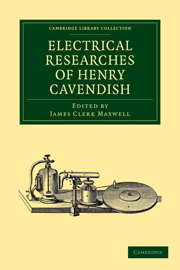PART II - CONTAINING A COMPARISON OF THE FOREGOING THEORY WITH EXPERIMENT
Published online by Cambridge University Press: 05 July 2011
Summary
98] § 1. It appears from experiment, that some bodies suffer the electric fluid to pass with great readiness between their pores; while others will not suffer it to do so without great difficulty; and some hardly suffer it to do so at all. The first sort of bodies are called conductors, the others non-conductors. What this difference in bodies is owing to I do not pretend to explain.
It is evident that the electric fluid in conductors may be considered as moveable, or answers to the definition given of that term in page 6. As to the fluid contained in non-conducting substances, though it does not absolutely answer to the definition of immoveable, as it is not absolutely confined from moving, but only does so with great difficulty; yet it may in most cases be looked upon as such without sensible error.
99] Air does in some measure permit the electric fluid to pass through it; though, if it is dry, it lets it pass but very slowly, and not without difficulty; it is therefore to be called a non-conductor.
It appears that conductors would readily suffer the fluid to run in and out of them, were it not for the air which surrounds them: for if the end of a conductor is inserted into a vacuum, the fluid runs in and out of it with perfect readiness;
- Type
- Chapter
- Information
- Electrical Researches of Henry Cavendish , pp. 44 - 63Publisher: Cambridge University PressPrint publication year: 2010First published in: 1879



